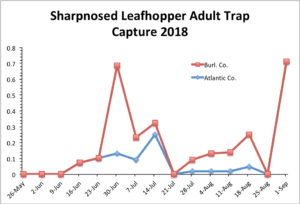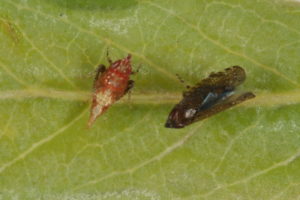Peach:
Peachtree Borer (PTB) and Lesser Peachtree Borer (LPTB): Now is the time to treat for peachtree borers and lesser borers. PTB has one generation per year, while LPTB and 2 generations per year. Over the last 10 years PTB has caused more problems than LPTB. It is not unusual to find multiple borer larvae in a single mature tree. At minimum this is a stress that the trees do not need to survive the winter and be productive for the following season. Too many larvae can kill the tree, and in young trees only 1-2 larvae can kill the tree. The trick is to apply insecticide soon after most of the eggs have been laid, which is now, and before the larvae get too established in the trunk. Lorsban has been the best product available for this use, and must be used now after the fruit is off and while the larvae have just emerged. Make sure to apply liberal amounts of water in a high volume soaking spray directed at the trunk. This is likely the last year that Lorsban will be able to be used. When Lorsban is gone, mating disruption will need to take its place, and applied in the Spring. Other insecticides are also labeled for this pest, but they have been shown to be less effective.
Both Apples and Peaches:
Brown Marmorated Stink Bug (BMSB): BMSB captures have increased on several farms, particularly in northern counties. Some late season damage is also showing up on early harvesting apples. Growers need to protect the fruit with short PHI insecticides at this time of year, especially with increased activity. BMSB effective materials that have a 7 day or less PHI include Baythroid (Apple, Pear and Peach), and Belay (Apple, Pear only). Dinotefuran – Venom and Scorpion, can be used under section 18 labels for the high rates effective for BMSB. These labels state a 3 day PHI for both pome fruit and stone fruit. Both products are toxic to bees and should be used when there are no flowering weeds in the orchard to attract bees. The Venom rate is 4-6.75 oz/A, and the Scorpion rate is 8-12 oz/A (both have a 2 application maximum). Make sure to apply thorough coverage, make frequent applications, and rotate chemistries as much as possible.
Blueberry:
Sharpnosed Leafhopper (SNLH): The SNLH population this year has been very low. The middle to end of August is generally the time when adult populations start to increase as the nymphs start to mature. Treatments for the second generation are usually timed to be close to the second adult flight peak. This has been almost non-existent this year. During the week ending September 1 an average of 0.71 adults were found on Atlantic County farms and none were found on Burlington County farms. Normally, we would not suggest treating until adult trap captures are higher. Nymphs don’t have wings, so they can’t fly and get caught in the traps or spread stunt disease (see photo with nymph on left and adult on right). However, there are exceptions to this timing. One point that was made earlier this week was if a grower were to start rogueing bushes, would this affect his treatment decision? The answer is yes, since it is likely that moving labor and equipment through the fields is likely to mechanically spread the nymphs, thereby ‘artificially spreading’ the stunt disease vector. Therefore if you are doing such field activities now, it would be beneficial to treat even though trap counts still show low adult populations. It is also likely that adult populations may increase over the next couple of weeks.

Sharpnosed Leafhopper Adult Trap Catch Record.

Sharpnosed leafhopper nymph on left and adult on right.

